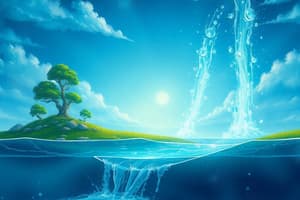Podcast
Questions and Answers
What drives the water cycle primarily?
What drives the water cycle primarily?
- Tidal energy
- Geothermal energy
- Solar energy (correct)
- Wind energy
Which of the following is not a form of precipitation in the water cycle?
Which of the following is not a form of precipitation in the water cycle?
- Sleet
- Fog (correct)
- Hail
- Rain
What is the main process that replenishes groundwater reserves?
What is the main process that replenishes groundwater reserves?
- Evaporation
- Infiltration (correct)
- Condensation
- Runoff
Which environmental issue directly impacts the quality of the atmosphere?
Which environmental issue directly impacts the quality of the atmosphere?
How does air pollution contribute to weather pattern changes?
How does air pollution contribute to weather pattern changes?
What is the main difference between primary and secondary pollutants?
What is the main difference between primary and secondary pollutants?
How can air pollution impact the water cycle?
How can air pollution impact the water cycle?
What role does water vapor play in the formation of weather patterns?
What role does water vapor play in the formation of weather patterns?
How do temperature gradients influence weather patterns?
How do temperature gradients influence weather patterns?
How does air pollution contribute to global warming?
How does air pollution contribute to global warming?
Flashcards are hidden until you start studying
Study Notes
Water, Air, and Atmosphere: Understanding the Interconnected Cycles and Challenges
The world around us is characterized by the constant and interconnected flow of water and the composition of our atmosphere. These two fundamental elements, water and air, are essential to life on Earth, and together, they form a complex and intertwined system that sustains our planet. In this article, we'll delve into the water cycle, air pollution, and weather patterns—the three subtopics that help us understand the water-air-atmosphere relationship.
The Water Cycle
The water cycle is the continuous movement of water from the Earth's surface through evaporation, to the land via precipitation, and back to the surface via runoff and infiltration. It's a fundamental process that sustains life on our planet, and it's driven primarily by solar energy, which causes water to evaporate from oceans, lakes, and other bodies of water.
Evaporation is the process by which water is transformed into water vapor and rises into the atmosphere. Once in the atmosphere, water vapor can form clouds, which release their moisture through condensation, forming precipitation in the form of rain, snow, sleet, or hail. Precipitation then falls back to the Earth's surface, where it is collected by streams, rivers, and lakes, or it infiltrates into the ground to replenish groundwater reserves. This water may then evaporate once more, continuing the cycle.
Air Pollution
The air we breathe is fundamental to our survival, and yet, it is often compromised by pollutants. Air pollution refers to the release of harmful substances into the air that can negatively affect our health, ecosystems, and the environment.
There are two main types of air pollution: primary pollutants and secondary pollutants. Primary pollutants are released directly into the atmosphere, such as sulfur dioxide, nitrogen oxides, and particulate matter. Secondary pollutants are formed from chemical reactions between primary pollutants and other substances in the atmosphere. Examples of secondary pollutants include ground-level ozone and acid rain.
Weather Patterns
Weather patterns refer to the long-term, large-scale atmospheric circulation and movement of air masses that affect climate and weather conditions. As water vapor rises and cools, it condenses to form clouds, which release precipitation as it descends. This precipitation can lead to the formation of weather patterns, such as the monsoon season, where warm, moist air collides with cooler air masses, leading to heavy rainfall.
Weather patterns are influenced by a variety of factors, including temperature gradients, wind patterns, and the presence of high or low-pressure systems. These patterns can change over time, resulting in changes to the Earth's climate.
Interconnectedness of Water and Air
The water cycle and air pollution are two interconnected aspects of the water-air-atmosphere system. As water evaporates from the Earth's surface, it releases heat, which helps to drive the water cycle. However, the water vapor released during evaporation can also contribute to air pollution by forming secondary pollutants.
Air pollution can also impact the water cycle by affecting the Earth's climate. For example, particulate matter in the atmosphere can trap heat, leading to global warming and changes to the water cycle. Air pollution can also lead to acid rain, which can harm aquatic ecosystems and contribute to the corrosion of buildings and infrastructure.
Conclusion
Water, air, and the atmosphere are three fundamental elements that are interconnected on our planet. Understanding the water cycle, air pollution, and weather patterns can help us appreciate the complexity of our Earth and the importance of protecting it. By reducing pollution, conserving water, and adopting sustainable practices, we can ensure that our planet remains a habitable and thriving environment for generations to come.
Studying That Suits You
Use AI to generate personalized quizzes and flashcards to suit your learning preferences.





